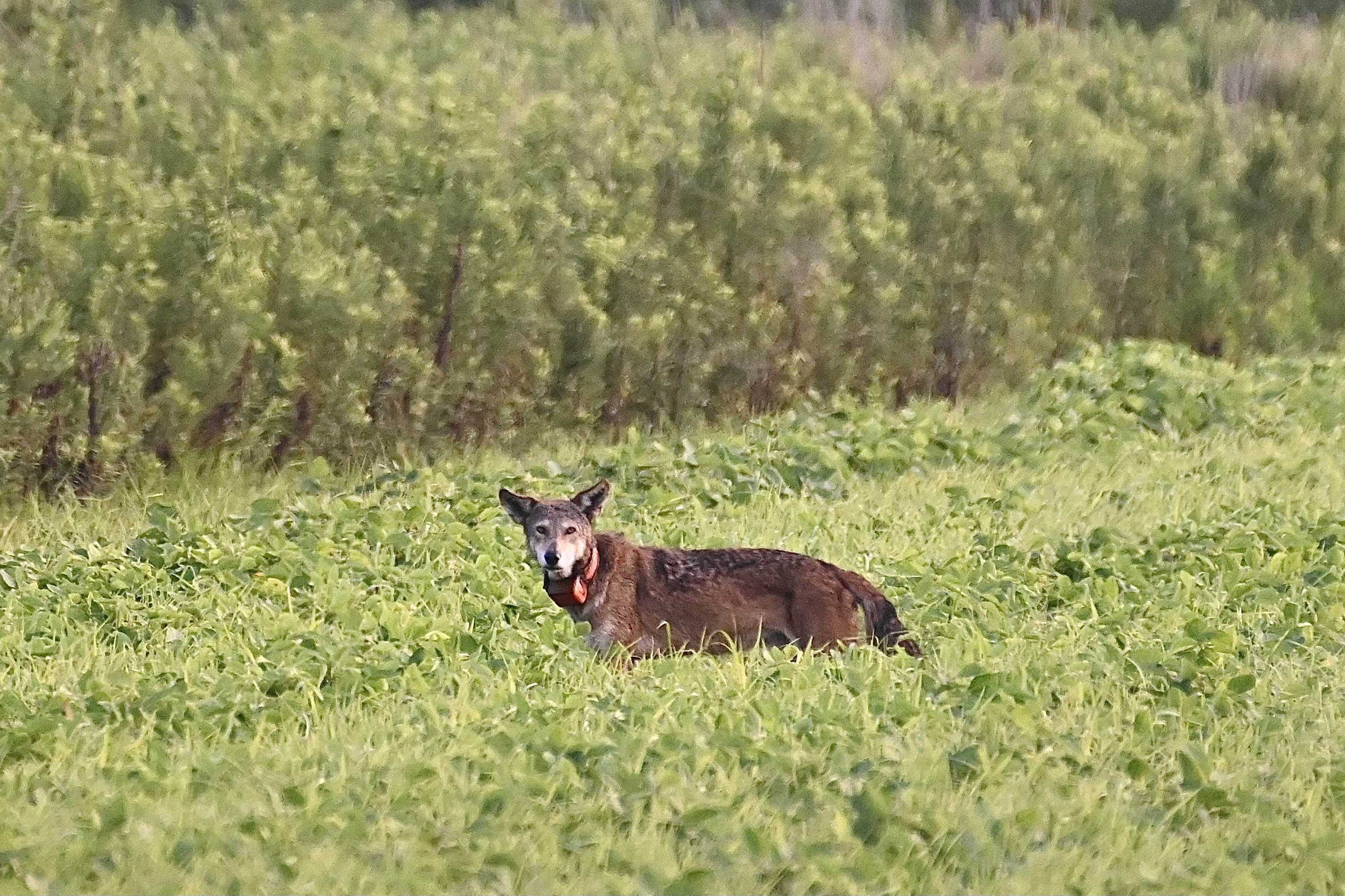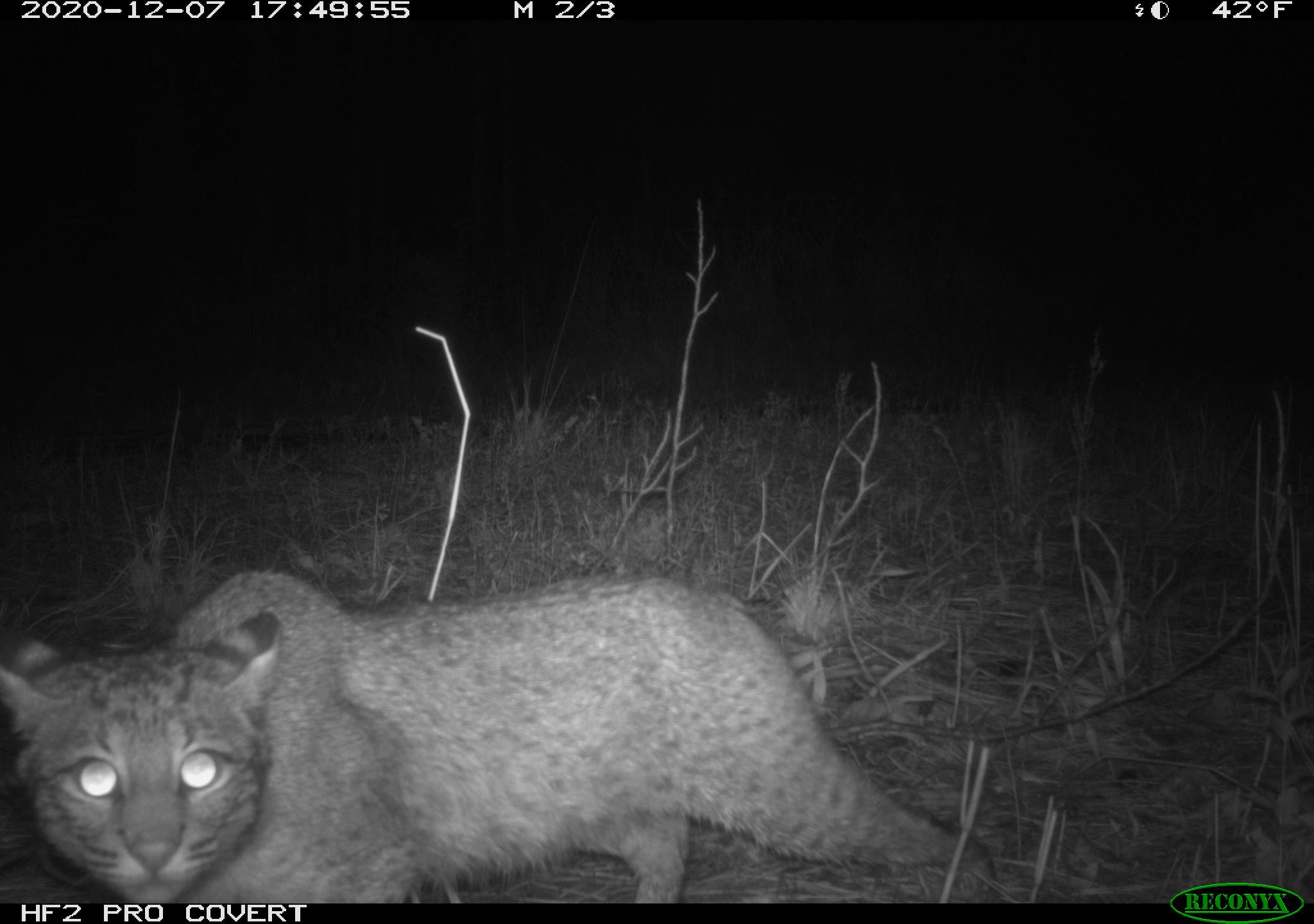A Call for Crossings: The High Toll for Red Wolves
A young red wolf in the Alligator River National Wildlife Refuge. One of the last remaining in the wild. Photo by: Aspen Stevanovski
“The wolves are being killed almost as fast as they are being released from captivity and bred in the wild. Without crossings and fencing on U.S. 64, it is going to be really hard to maintain a successful red wolf population.” - Ron Sutherland, PhD, Wildlands Network’s Chief Scientist
Red wolf (identified as 2323M) living on the Alligator River NWR. Photo by: Aspen Stevanovski
In a classic American paradox, 237 square miles of land preserved as a national wildlife refuge in North Carolina is sliced by a major highway, U.S. 64, the busy road that takes tourists to the famous Outer Banks. The Alligator River National Wildlife Refuge (NWR) is true to its name: it’s an essential respite for a huge diversity of wildlife including turtles, alligators, snakes, otters, bobcats, deer, birds, black bears, and much more.
Wildlife living on the Alligator River NWR. Photos by: Wildlands Network
It’s no surprise that the stretch of U.S. 64 that cuts through the refuge has a reputation for inflicting wildlife carnage. With help from numerous experts, Wildlands Network named it as the top-priority for wildlife-road mitigation efforts in eastern North Carolina.
The refuge is also a core part of the last-remaining home to one of the most endangered species in the world: the red wolf.
The fields and forests that make up the north end of Alligator River NWR provide (apart from the adjacent highway) ideal habitat for the Milltail pack, one of the most successful and resilient red wolf packs that has survived through generations of fluctuation since the red wolves were first reintroduced back in 1987.
Like all wolves, the pack’s success is dependent on its relationships. Wolves are highly social creatures, generally mating for life and relying on the entire pack of parents and pups (until they disperse after one to two years) for survival. They hunt together, protect each other, and bring food to nursing moms and the youngest of the group.
A young male, 2323M , was released in 2021 with the hopes of pairing with 2225F, the only remaining breeding-age female in the Milltail pack. “I saw 2323M in person right after he was released while he was courting with the Milltail female in March 2021. It was a magical spring day, and the wolves' future seemed really bright,” said Ron Sutherland, PhD, Wildlands Network’s Chief Scientist.
2323M (right) and 2225F (left) courting on the refuge in March 2021. Photo by: Ron Sutherland
2225F and 2323M paired in 2021 and mated in 2022, and with that, the next generation of the Milltail pack was born as six new red wolf pups entered the world.
“2323M seemed to be a successful red wolf father and was frequently observed hunting,” noted Dr. Sutherland. The next summer (2023), the Milltail pair had another litter, totaling 11 new Milltail pups between the two seasons, a remarkably positive turn of events for a red wolf population that had seen a several-year period with no pups born in the wild.
Wolf pups are vulnerable and reliant on their parents and siblings until they can start hunting at around six months old. During these early months, the pack takes turns bringing food back to the family.
“I once watched 2323M walk back from a hunt with one of his yearlings. The young guy had just caught a rabbit. Without hesitation, 2323M took the rabbit from his son’s mouth and gave it to his partner for a much-needed meal,” remembered Aspen Stevanovski, wildlife photography guide who frequently visits Alligator River NWR, and who has worked with Wildlands Network on our camera trap data analysis.
2225F and pups. Photo by: Aspen Stevanovski
Things looked promising. However, once again, the plight of human development took its toll on this pack. Last fall, while 2323M was out hunting, he strayed too close to the highway, likely drawn by the carcass of a road-killed bear. A driver hit and killed him on U.S. 64 in September 2023.
“Every red wolf mortality is a crushing blow as I know the impacts on this extremely small population,” said Dr. Sutherland. “But 2323M's death hit the hardest as I’d seen him in person and watched him work so hard to raise and feed two litters of pups. It was really tragic to hear he had been killed by a vehicle strike.”
Red wolves howl at Alligator River NWR. Photo by: Wildlands Network
And the toll continued. A few months later, their son (2410M, the largest of the 2022 pups) attempted to disperse in hopes of finding his own territory and mate. His dispersal was cut short as he crossed U.S. 64 and was quickly killed by a car in April.
Despite these losses, the Milltail pack forged on. 2225F picked up a new mate in early this year when the USFWS released a captive male (2191M) in January. Together, they had another huge success – a litter of eight pups in June!
At the same time, USFWS red wolf staff also set up another breeding pair at Alligator River, putting 2413F (a wild female from the Milltail pack born in 2022) into a pen with 2444M (a captive-born male). The two young wolves had a litter of pups in the acclimation pen and then were released into the refuge. However, highway disaster struck again when the male was killed by a vehicle strike on June 5, 2024. USFWS is attempting to do what they can to make sure 2413F and her young pups survive.
A red wolf from the Milltail pack. Photo by: Aspen Stevanovski
“Unfortunately, the fields that the wolves prefer are located close to the highway. We don't have any huge roadless areas in the region, so we need to solve the roadkill issue here at Alligator River NWR and elsewhere as the red wolf population hopefully expands,” said Dr. Sutherland.
These wolves from the Milltail pack are three of the five red wolves killed by cars in the last 12 months.
While each of these losses is tragic and disappointing, they underscore the critical need for a proven solution: wildlife crossings. In conjunction with fencing, wildlife crossings reduce vehicle-wildlife collisions by as much as 90% or more.
Wildlands Network is actively promoting the construction of crossings and fencing for U.S. 64. This effort recently hit a huge milestone when an anonymous donor made a very generous challenge offer to Dr. Sutherland: they would donate $2 million to help build crossings if we can raise an additional $2 million match.
The combined $4 million would then be used by the North Carolina DOT as the required 20% non-federal match for a $16 million proposal to the Wildlife Crossings Pilot Program. Thus, any new funds we can raise to meet the challenge will be leveraged at an incredible 9:1 ratio, if the federal proposal is successful!
Walking along a gravel road in the refuge. Photo by: Wildlands Network
The Center for Biological Diversity, National Parks Conservation Association, and other partners have joined us as we work to bring the U.S. 64 crossings to reality.
Wolves have been using crossing structures in Canada’s Banff National Park in Canada for years. Wildlands Network also observed wolves using underpasses in one of our road ecology projects in the western U.S. This data suggests they would work for the red wolf, too.
A wildlife crossing across U.S. 64 combined with extensive fencing could help save this species from extinction. And that’s not all it would do! It would also benefit a tremendous number of other species like black bears, deer, bobcats, turkeys, and other wildlife that call the Alligator River NWR home.
These wolves face a daunting future. According to Dr. Sutherland, “If we can seal off U.S. 64 and keep the red wolves and other wildlife at Alligator River NWR safe from highway traffic, we will have made a huge difference in the survival of the red wolves. With crossings and fencing, the wolves should be able to start growing their population again in eastern North Carolina.”
9/17/2024 Update: Today, the U.S. Fish and Wildlife Service confirmed that after 2444M was killed by a car in June, his entire litter of five pups died over the summer. Less than 20 red wolves remain in the wild. We're making progress toward a wildlife crossing over US 64 to save this species from extinction. Our $2 million pledge supported a $25 million proposal that the North Carolina DOT submitted in September to fund a wildlife crossing. Stay tuned for updates.
To donate to the Red Wolf Crossing Challenge Fund, click here. These funds will be passed on directly to North Carolina DOT.
To donate to Wildlands Network to support our red wolf staff and fieldwork, click here.














